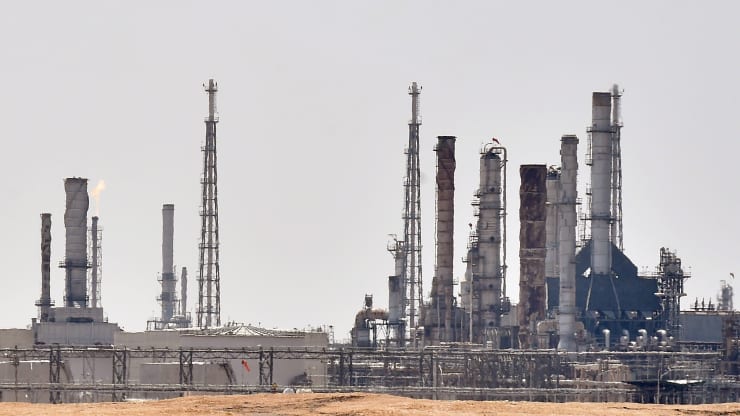Attacks on Saudi oil facilities have prices soaring and markets pressured over the threat of amilitary response.
Oil prices slid on Tuesday, although the market remains on tenterhooks over the threat of a military response to attacks on Saudi Arabian crude oil facilities that halved the kingdom’s output and prompted a price spike not seen in decades.
Saturday’s attacks raised the prospect of a major supply shock in a market that in recent months has focused on demand concerns due to the pressure on global growth from an ongoing U.S.-China trade dispute. Saudi Arabia is the world’s top oil exporter and has been the supplier of last resort for decades.
Brent crude was down 36 cents, or 0.5%, at $68.66 a barrel at 0930 GMT, and West Texas Intermediate was down 57 cents, or 0.9%, at $62.33 a barrel. Earlier, the crude benchmarks both fell by around 2%.
On Monday, the prices surged nearly 20% in intraday trading in response to the attacks, the biggest jump in almost 30 years, before closing nearly 15% higher at four-month highs.
Saudi energy minister Prince Abdulaziz bin Salman will hold a news conference at 8.00 pm local time (1700 GMT).State-owned producer Saudi Aramco has not given a specific timeline for the resumption of full output.
“All eyes will be on the Saudi news conference,” said Samuel Ciszuk, founding partner at Stockholm-based ELS Analysis.
“We need a proper damage assessment, we need to see a recovery plan. Before that, we don’t really know how much oil will be offline for how long and that’s the basic question people having been posing since Saturday.”
The attacks on Saudi Aramco’s crude-processing facilities at Abqaiq and Khurais cut production by 5.7 million barrels a day, the largest single supply disruption in half a century, and threw into question its status as supplier of last resort.
The fallout in Asia, the largest buyer of Saudi crude, has been varied, with some refineries expected to receive their allocated volumes for October, and other importers being told of delays or being offered alternative grades.
The prospect of oil releases from strategic inventories in the United States, the International Energy Agency and some big buying countries such as Japan have weighed on prices, but the geopolitical threat of retaliation in the Middle East is causing concerns.
“High stock levels mean that no shortage of supply is likely … On the other hand, there is a danger of further escalation, which would necessitate a substantial risk premium on the oil price,” Commerzbank oil analyst Carsten Fritsch said.
U.S. President Donald Trump said on Monday it looked like Iran was behind attacks, but stressed he did not want to go to war. Tehran has rejected the charges that it was behind the drone strikes.
Relations between the United States and Iran have deteriorated since Trump pulled out of the Iran nuclear accord last year and reimposed sanctions on its oil exports.
Washington also wants to pressure Tehran to end its support for regional proxy forces, including in Yemen where Saudi forces have been fighting Iran-backed Houthis for four years. The Houthis claimed responsibility for Saturday’s attacks.
“It’s not a great thing to say, but if something like this is going to happen, at least it happened at a time when there is a surplus in crude and U.S. production is growing at such a fast clip,” said Tony Nunan, Tokyo-based oil risk manager at Mitsubishi Corp.

